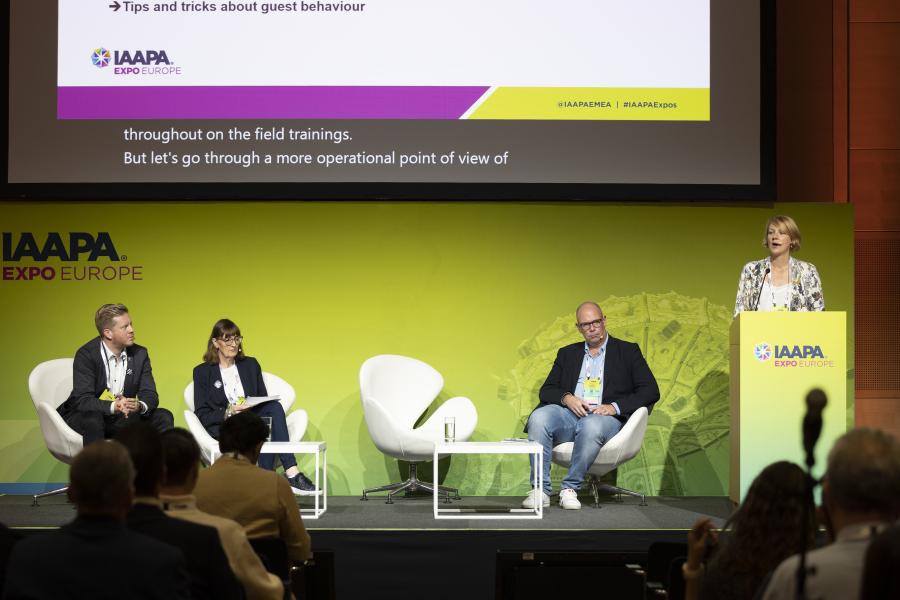Safety is the attractions industry’s number-one priority. Enhancing safety is a dynamic process. A panel of industry safety advocates at IAAPA Expo Europe believe the approach must also be holistic—it is not enough to focus on the technical side of safety; operators must also consider every variable.
“We should always be aware of the unpredictable behavior of our visitors,” says Charlotte Looten, operations director at Bellewaerde, in Ieper, Belgium. Self-awareness is important too, she adds. “As managers, supervisors, and directors, we always have to deal with the unpredictable behavior of our own staff members.”
For example, Looten asserts first impressions matter, so how team members look and act in front of guests is crucial. “Guests will mirror their behavior on yours,” she explains. If you cross a fence, for example, they might do the same.
“It’s important to find the right balance between guest satisfaction and safety and between empathy and assertiveness,” she believes. Although staff must make the experience fun for guests, “they need to know the limits.” Height and weight restrictions must be respected, no matter how much an employee wants to deliver good guest service and make a guest’s day. Safety requires a consistent approach from all colleagues. Looten also emphasized how managers need to support staff who might be having challenging conversations with guests.
Bellewaerde teaches staff how to recognize cues for risky behavior. “If you see a child being carried by their parent, we can be 90% sure that the child will be too small to ride.” If visitors are being noisy and exuberant, it is an indication that they are likely to cause disruptions. “Operators need to recognize this and call their supervisors. Staff need to feel supported by the whole company,” she says.
Operators have noticed changes in guest behavior since COVID-19. “Guests are becoming more demanding,” says Daniel Lindberg, head of operations at Liseberg in Gothenburg, Sweden.
Lukas Metzger, head of park operations at Europa-Park in Rust, Germany, pointed to the influence of social media platforms such as TikTok. He notes a “horrible need for attention” reflected in some user’s posts. Metzger showed video clips of unruly behavior on social media. Europa-Park comments that they will ban guests making poor choices from the park, and swiftly report the videos.
“Guests expect to be treated like ‘the customer is always right,’ but when it comes to safety that cannot be the case,” says Lynne Walker, senior operations manager at Legends Hospitality/Legends Global Attractions.
“Guest service training should include safety training,” she says. “Ride operators need the confidence to say ‘no’ to guests.” With the right training, they can provide reasons why. “Communication is the key,” Metzger told attendees.
Companies must embed safety into their culture according to Walker. “The hardest part of creating any culture is you have to live it, and you have to make it interesting enough for your employees to want to live it too,” Walker says.
Safety must start with inductions—for all staff. “Making safety real and relevant for employees can be very challenging,” she says. Technology can help, but face-to-face training is essential. Attractions must keep reinforcing the safety message. “Weekly toolbox talks can be invaluable,” Walker shares. She recommends keeping notice boards updated with safety reminders and other exciting park news and using staff social media groups. “Don’t isolate safety—make it a part of the daily conversation,” she urges.
Companies must ensure that employees understand the consequences of their actions. Much of the safety focus is on guests, but “safety training must include the risks employees face,” Walker says.
Realistic emergency exercises can be hugely valuable. Walker was involved in a recreation that used actors and emergency services to roleplay an emergency at the park. “I cannot tell you how much impact this had on everyone,” she says. The park remained open during the exercise. “It was critical for us to keep operations moving and deal with a [simulated] emergency at the same time so that we could test our plans.” Staff set up a barrier around the reenactment and explained to guests what they were doing. They conveyed that the rides were safe, but they were training for all possible occurrences.
“Creating a culture that includes safety adds to your guest service, delivers your sales objectives, and improves your ability to raise standards,” Walker concludes.

